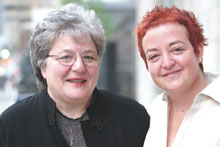Women want more room at the top of the academic pile

Dean of Graduate Studies Elizabeth Saccá with Elizabeth Cobbett, a student in the MA in Public Policy and Public Administration, who was awarded the Senior Women Academic Administrators of Canada Graduate Student Award of Merit. The other two winners of the award are also from Quebec. The awards were presented April 30 at the McCord Museum at a banquet that was part of a conference called Women on Top. Saccá co-hosted the conference, along with Martha Crago, from McGill. We hope to bring you more about Cobbett in the Great Grads feature of the June 3 issue of CTR.
Photo by Andrew Dobrowolskyj
Elizabeth Saccá, Concordia’s Dean of Graduate Studies, was proud to learn that Concordia leads Quebec universities in the number of women it has as professors, but her pleasure is tempered by the suspicion that the top showing does not reflect the true distribution of women academics at the university.
Concordia’s leading role in hiring women was laid out in one of the studies presented at the annual conference of Senior Women Academic Administrators of Canada (SWAAC), held at a downtown Montreal hotel April 29 to May 1.
Saccá would like to have a breakdown by Faculty and department in relation to the pool of available PhDs so she can get a better sense of how Concordia is doing on gender equity. Saccá thinks the Fine Arts Faculty (half of whom are women) and other areas with a higher number of women contribute to the overall number. She suspects that Concordia is no different from other universities when it comes to an uneven distribution of women among different fields.
Women continue to lag behind men in academic appointments almost everywhere in Canada. A study by Université Laval professor Hélène Lee-Gosselin shows that women made up only 31 per cent of Concordia’s professors in 1997 — although that was a big leap from 17 per cent a decade earlier.
Canadian Association of University Teachers (CAUT) figures show that at 34 per cent, Canada placed 12th among OECD countries in the proportion of women university faculty in 2001, compared with first-place Ireland at 48 per cent.
The 119 participants at the SWAAC conference heard plenty of gloomy statistics about women’s slow, or arrested, progress in the academic hierarchy. But far from being depressing, the conference acts as a stimulus for further action on the very important issues it raised, Saccá said.
“A lot of people are going back home to look at their own institution,“ she said. For example, Saccá wants to take a look at the gender distribution of fellowships at Concordia, as well as who gets various research monies from federal and provincial agencies.
Several conference speakers denounced the “scandalous“ allocation of the plummy Canada Research Chairs (CRCs) the federal government set up in 2000. Women hold a mere 13 per cent of the Tier 1 CRC chairs, which ensure funding for seven years and are intended to promote “international stars,“ and only 23 per cent of the Tier 2 chairs that offer funding for two to five years and target “rising stars.“
The program hasn’t been able to attract women in proportion to the pool available because it did not have gender equity as one of its goals, noted Suzanne Fortier, Queen’s University Vice-Principal (Academic). “If it’s not an explicit goal, it will not happen naturally,“ Fortier said.
Saccá would like also to examine PhD deadlines at Concordia to see if “there might be way to adjust for differences between men and women having children.“
In fact, family formation plays havoc with women’s academic job prospects, a groundbreaking study by the University of California at Berkeley has shown. The author of that study, Dean of Graduate Studies Mary Ann Mason, told the conference that for women academics “the reproductive train and the tenure train are often on a collision course.“
CAUT figures show that among full-time faculty in 2002-2003, women made up 26 per cent of tenured professors and only 15 per cent of full professors.
Lee-Gosselin’s data indicated that women held only 13 per cent of president positions in 2000-2002, 17 per cent of vice-presidents, 26 per cent of deans, and 23 per cent of department chairs. In the private sector, by comparison, women represented a median 20 per cent of top management.